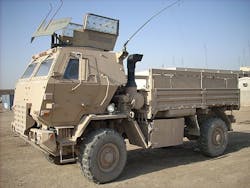Army orders 100 FMTV military trucks with integrated vetronics on SAE digital databuses
Officials of the Army Contracting Command in Warren, Mich., awarded the FMTV contract to Oshkosh to provide 88 of the FMTV military trucks for the U.S. Army Reserve, and 12 for the Kingdom of Jordan.
The FMTV is a series of vehicles with integrated vetronics that are based on a common chassis that range in payload from 2.5 to 5 tons, and vary by intended use. These vehicles are equipped with the SAE J1708 and J1939 electronic databuses for Class V intrusive diagnostics of four unique electronic control modules (ECM).
The FMTV includes cargo trucks and vans, as well as long-wheelbase cargo trucks, tractor trucks, wreckers, and dump trucks for local and line haul, unit mobility, resupply, and similar missions in combat, combat support, and combat service support units. The trucks are rapidly deployable worldwide and operates on primary and secondary roads, trails, and cross-country terrain, in all climatic conditions.
Related: Oshkosh Defense to provide U.S. Army's FMTV, a defense system for harsh environments
These vehicles, which include two companion trailers, offer air-drop capability, armored cabs, and roof gun mounts with shields. The FMTV A1 series has upgraded transmission, electronic databus, an anti-lock brake system, interactive electronic technical manuals, and a tire-pressure system that can be controlled from the cab.
The SAE J1939 databus is for communication and diagnostics among vehicle electronic components throughout the vehicle. With a different physical layer, it can communicate between the tractor and trailer.
Story continues below
SAE J1939 defines five layers in the seven-layer OSI network model, and this includes the Controller Area Network (CAN) 2.0b specification for the physical and data-link layers. Under J1939/11 and J1939/15, the baud rate is specified as 250 kilobits per second, with J1939/14 specifying 500 kilobits per second.
All J1939 packets, except for the request packet, contain eight bytes of data and a standard header which contains an index called Parameter Group Number (PGN), which is embedded in the message's 29-bit identifier. SAE J1939 has been adopted widely by diesel engine manufacturers.
Related: Army vehicle will run on Cobasys battery
The SAE J1708 is a serial databus for communicating among electronic control units (ECUs) and between a computer. The J1708 standards defines the physical layer, and common higher-layer protocols that operate on top of it are SAE J1587 and SAE J1922.
The standard defines a two-wire 18 gauge cable that can run as far as 130 feet and operates at 9600 bits per second. J1708 messages have as many as 21 characters, and transmit over RS-485 transceivers. Several devices can share the bus without the need for a single master node.
Other electrical systems on the FMTV include 12/24-volt, EMI/HAEMP qualified resetable circuit breakers and a central power distribution panel. The trucks also have 100 amp, 12/24 volt, waterproof, EMI/RFI suppressed alternators and 24-volt waterproof starters.
Related: BAE Systems gets $28.7 million contract modification for armored recovery vehicles
The FMTV's central tire inflation system provides cab-mounted electronic controls that the driver can operate while driving on highways, cross-country, during air transport, and in sand/mud/snow and emergency modes.
On this contract Oshkosh will do the work in Oshkosh, Wis., and should be finished by October 2015. For more information contact Oshkosh Corp. online at http://oshkoshdefense.com, or the Army Contracting Command-Warren at www.tacom.army.mil.
